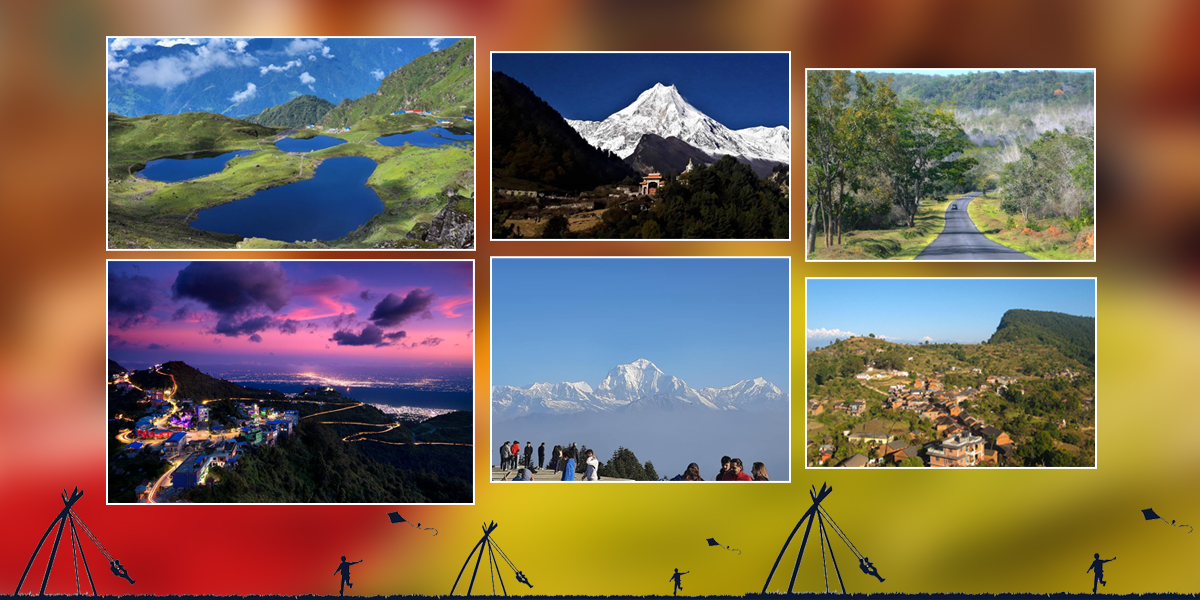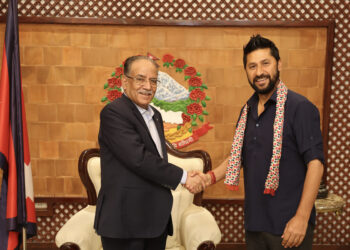KATHMANDU: The number of Nepalis wandering around during festivals is on the rise.
Driven by a burgeoning middle class and a growing tourism culture, many of the tourists visiting major destinations in recent years are fellow Nepalis.
From Kechnakawal in Jhapa to the caves in Mustang, domestic travelers now outnumber foreigners.
Additionally, travel companies are offering various packages specifically targeting domestic tourists during the festival season.
As the Dashain holiday approaches, many Nepalis are seizing the opportunity to travel.
With several offices closed or downsized, individuals are eager to explore suitable travel destinations during the week-long festival leave.
While a few thousand choose to travel abroad, millions are focusing on internal destinations, solidifying Nepal’s status as a top travel destination.
Accommodations in Jumla are available for about Rs 1,000, and a two-day trek to Rara Lake will cost around Rs 3,000. Additional expenses will depend on your personal spending habits.
Those with family ties typically stay with relatives until Bijaya Dashami, after which they often gather with friends for outings.
Conversely, individuals unable to celebrate with family may opt for tours following the holiday.
This year’s Dashain festivities have already invigorated the Nepali population.
In light of recent natural calamities, an increasing number of people are returning to their villages from Kathmandu and other regions.
Despite some major highways being closed due to floods, the use of alternative routes is rising, and air travel is an option for those willing to spend a bit more.
Dashain is the perfect time to plan travel itineraries for family and friends, ranging from trekking to various religious sites.
Here are 15 recommended destinations for making the most of the holidays starting from Fulpati (Saptami).
Mardi Himal Trek
The Mardi Himal trek is an ideal choice for those looking to make the most of their limited Dashain holiday.
In recent years, the number of trekkers to this destination has surged, especially during the Dashain-Tihar season when both internal and external tourists flock to the trails.
Located not far from Kathmandu, the trek primarily takes place in Machhapuchhre Rural Municipality of Kaski.
The Mardi Himal Basecamp is approximately 31 km from Pokhara, the tourist capital of Nepal, and the trek spans about 57 km.
The five-day Dashain holiday is an ideal time for the Mardi Himal trek, which is often regarded as less expensive and more accessible than other destinations.
It has been frequently recognized as one of the best trekking routes in the world.
For those planning the trek, a bus to Kande can be taken after reaching Pokhara.
From there, trekkers should embark on their journey at the fork on the Pokhara-Baglung Bhupi Sherchan highway.
A day’s trek to the Australian Base Camp provides breathtaking views of the Himalayas and Pokhara.
This spot is the highlight of the Mardi Himal trek, offering refreshing Himalayan waters that revive weary souls.
It is advisable to arrange food and accommodation in advance for a smooth trekking experience.
The total cost to reach the Mardi Himal trek by road is approximately Rs 15,000, with options to adjust expenses based on preferences.
Pokhara
Pokhara stands as the tourist capital of Nepal. Whether arriving by road or air, visitors are immediately enchanted by the stunning scenery and ambiance.
As the most frequented destination in Nepal, Pokhara welcomes both domestic and international tourists each year, boasting a climate that is neither too hot nor too cold.
The rainy season enhances its natural beauty, with Fewa and Begnas lakes serving as central attractions in Kaski district and the capital city of Gandaki Province.
Pokhara is a unique blend of mountains, lakes, temples, monasteries, and adventure tourism, offering an extraordinary mix of tangible and intangible experiences.
The area features modern hotels along the lakeside, catering to all spending capacities, ensuring that every visitor experiences true Nepali hospitality.
Pokhara is a sought-after destination for tourists visiting Nepal.
In recent years, there has been a significant increase in domestic tourists flocking to this city, renowned for its natural beauty and rich cultural heritage.
Travelers can tailor their budgets according to their preferences; with around seven thousand rupees, you can explore Pokhara while enjoying an experience as expansive as the lakes and as lofty as the surrounding peaks.
Rara Lake
As you may know, Rara Lake is the largest lake in Nepal, situated in Mugu district of Karnali Province.
This vast body of clear water rests at an altitude of 2,972 meters above sea level, offering breathtaking views and a serene atmosphere that appeals to those seeking a heavenly escape.
The best time to visit Rara Lake is between October and November, particularly during Dashain and Tihar.
You can reach Rara Lake by both air and road. A road trip from Nepalgunj through Jumla to Mugu headquarters, Gamgarhi, is possible.
This journey takes approximately 30 hours from Kathmandu to Jumla, followed by a seven-hour trek to Rara Lake.
The main route from Surkhet is via Kalikot, where you can take a jeep to Jumla.
An early morning departure from Khalanga allows for an easy evening arrival at Rara Lake.
If you opt for the most budget-friendly route, around Rs 20,000 will suffice for a round trip to Kathmandu.
This includes Rs 2,700 for transportation from Kathmandu and about Rs 1,000 for lunch along the way.
Rare wildlife, such as the Himalayan Tahr, along with breathtaking vistas of Langtang Himal and Ganesh Himal, captivates visitors.
Accommodations in Jumla are available for about Rs 1,000, and a two-day trek to Rara Lake will cost around Rs 3,000. Additional expenses will depend on your personal spending habits.
For horse riding around Rara Lake, Rs 2,000 will cover one night’s stay and meals.
If you choose to return via the same route, expect to spend approximately Rs 17,000 to get back to Kathmandu. If you prefer to fly back, adjust your budget accordingly.
Khaptad
The Sudurpaschim Province of Nepal is breathtaking, with Khaptad offering a unique blend of natural beauty and spiritual significance.
Known as a paradise on Earth, Khaptad is famous for its stunning landscapes, including 22 Patans and 53 hillocks.
This area features various religious sites such as Khaptad Baba’s hut, Triveni River, Khaptadr Daha, Shiva Temple, Saharsha Ling, Ganeshsthan, Nagdhunga, and Kedar Dhunga.
It’s a must-visit for anyone looking to explore the hidden gems of their own country!
Khaptad National Park spans four hilly districts in the Sudurpaschim: Bajhang, Bajura, Doti, and Achham.
With a well-planned itinerary, you can fully enjoy the beauty of this region.
Visiting Khaptad is also a great option if you wish to witness the season’s first snow.
To travel from Kathmandu, you can fly to Dhangadhi’s Geta Airport, which allows for more time to explore Khaptad.
A car journey from Kathmandu to Attaria in Kailali takes about 15 hours.
From Dhangadhi, it takes approximately 9 hours by car to reach Jhigrana, where the park area begins.
The trek to Khaptad from there takes around 8 hours. You can access Khaptad via multiple entrances from Attariya, with the nearest road connection being from Bajhang Channa’s Meltadi, which takes just two and a half hours.
Traveling from Doti to Khaptad involves a 10-hour journey to Jhigrana market by booking a car from Attariya.
There are homestays and hotels with good amenities available for accommodation and meals. The airfare from Geta Airport to Dipayal is around Rs 5,000.
If you choose to fly from Kathmandu to Khaptad and back, the cost will be a minimum of Rs 40,000. Traveling by land will reduce your expenses to about Rs 20,000.
Langtang
The Langtang National Park, spanning Nuwakot, Sindhupalchowk, and Rasuwa, is an attractive destination for both domestic and international tourists.
Known for its snowy landscapes, Langtang offers a unique opportunity to experience rich biodiversity, stunning mountain views, natural hot springs, and vibrant Buddhist culture.
Once you reach Panchpokhari, you’ll be greeted by stunning views of sheep grazing along the trails and the majestic peaks of Gaurishankar, Dorje Lakpa, Jugal, and Rolwaling mountains.
Rare wildlife, such as the Himalayan Tahr, along with breathtaking vistas of Langtang Himal and Ganesh Himal, captivates visitors.
Travel to Langtang can be accomplished via helicopter or bus from Kathmandu.
Every morning, public transport departs from Machhapokhari in Kathmandu to Syafrubensi in Rasuwa. Alternatively, you can use a private car or motorcycle if you have one.
Public buses leave Machhapokhari between 6 AM and 9 AM and take approximately 6-7 hours to reach Syafrubensi, passing through Balaju, Kalanki, Thankot, Galchi, Nuwakot, and Dhunche.
The trek from Syafrubensi adds an element of excitement to the journey.
After a three-hour walk from Syafrubensi, you’ll reach Bambo, where you can spend the night.
The next morning, you can continue your trek through Kanjing Monastery to Langtang Kholaikhola.
The beautiful waterfalls and the sound of chirping birds will immerse you in nature.
Consider dedicating another day to travel from Kanjing Valley to Kanjing Ri.
Some trekkers also explore Ylapik and Sergoeri after reaching Kanjing. It takes about two and a half hours to get from Gumba to Kanzing-re and Kanzing-2.
While you can return to Kathmandu from Kanjing Ri, staying longer in Langtang is highly recommended.
During Dashain, setting aside five days and a budget of at least Rs. 15,000 for a trip to Langtang is a great way to make the most of your time.
Panchpokhari
Panchpokhari in Sindhupalchowk has recently emerged as a popular destination for tourists, especially as a nearby hiking trail from Kathmandu.
This area is quickly becoming a favorite for trekking enthusiasts.
To reach Panchpokhari, you’ll need to take a bus from Chabahil in Kathmandu.
It’s not possible to reach Panchpokhari in a single vehicle; you must take one vehicle to Melamchi and then switch to another.
Five days are sufficient to explore Panchpokhari, and the trip is relatively inexpensive, requiring around Rs 8,000.
Public transport from Chabahil to Melamchi costs Rs 500, while the fare from Melamchi to Chimti is Rs 400.
The trek toward Panchpokhari begins from Chimti, where accommodations are available after about three hours of walking.
While in Kanyam, be sure to capture photos of the people, who have been part of Nepal’s heritage for centuries, picking tea leaves amidst the stunning landscape.
Once you reach Panchpokhari, you’ll be greeted by stunning views of sheep grazing along the trails and the majestic peaks of Gaurishankar, Dorje Lakpa, Jugal, and Rolwaling mountains.
Mustang
In addition to being a revered pilgrimage site, the Himalayan village of Jomsom has become a significant tourist attraction.
Mustang is particularly famous for its apples, which flourish in the region.
The hills are painted with vibrant colors from ripe apple orchards, and Mustang’s juicy apples are simply irresistible—just thinking about the fresh apple juice is enough to make your mouth water!
When returning from Muktinath, visitors often bring apples as gifts along with blessings. So, plan a trip to Mustang during Dashain and Tihar (October) to savor these delicious apples.
Trekking in Nepal
One of the most renowned trekking routes in Nepal is the Ghandruk-Ghorepani-Poon Hill trail.
Located in Myagdi district, this destination has recently gained popularity among domestic tourists.
From Pokhara, it takes about 6 hours by car to reach Banthanti, a key starting point of the Annapurna Trail.
The trek begins here, leading you to Ghorepani after approximately three hours of walking. From Ghorepani, it takes an additional two hours to reach your destination, Poon Hill.
The trails are well-maintained, making Poon Hill a perfect spot for a refreshing walk in cooler weather.
A crucial tip: invest in shoes with good grip when trekking in high hills and mountainous regions, and avoid standing on black ice or frozen snow for your safety.
Plan for a 12-day return trek. If you have time off during Dashain and Tihar, consider undertaking the Poon Hill Padayatra during this period.
From Poon Hill, at an altitude of 3,210 meters, you can enjoy stunning views of the surrounding snow-capped peaks.
Accommodations in the Poon Hill area can host up to seven thousand tourists in a single night.
Ilam
Ilam is one of Nepal’s most picturesque regions, often referred to as the “district of sunrise” and the “queen of the mountains.”
The famous tea gardens of Kanyam are a must-visit, especially for those enchanted by the heartwarming love songs inspired by the Mai Khola (River).
Kanyam’s tea plantations attract both domestic and international tourists, while the refreshing breeze of Pakhapokhari, surrounded by tea gardens, is a welcome relief as winter approaches.
You can reach Ilam from Kathmandu in a day, but recent flash floods have blocked the BP Highway to the east.
You can reach Sauraha in Chitwan in about six hours by car from Kathmandu. Sauraha serves as the gateway to Chitwan National Park and is home to a large population of Tharus, one of Nepal’s traditional ethnic groups with a rich socio-cultural identity.
However, the road from Kathmandu to Ilam via Chitwan has been restored.
Alternatively, you can fly from Kathmandu to Bhadrapur Airport and then travel overland to Ilam.
While in Kanyam, be sure to capture photos of the people, who have been part of Nepal’s heritage for centuries, picking tea leaves amidst the stunning landscape.
From the hills of Kanyam, you can witness couples nurturing their love against the backdrop of lush tea plantations.
Shreeantu Danda, where the first rays of sunlight grace Nepal each morning, is another highlight. The area offers ample hotels for dining and accommodation.
Plan for a stay of two days to a week to fully enjoy your visit. Allow four days for travel from Kathmandu, and budget at least nine thousand rupees for your trip.
Pathibhara
Pathibhara, located in Taplejung district, is an ancient worship site for the Kirati people and holds significant religious importance for Hindus.
The area encompasses four municipalities: Phungling, Phattanglung, Pathibhara Yangwarak, and Sirijanga, making it a key pilgrimage destination in eastern Nepal.
Locally known as Mukkumlung by the Yakthung Limbus, this sacred site is believed to fulfill the wishes of those who visit.
Nestled in a picturesque highland setting, Pathibhara is particularly significant for worshippers of the Hindu tradition, which venerates feminine power.
Notably, this temple site has maintained its heritage architecture, as no additional buildings have been constructed around it.
To reach Pathibhara, you can take a car from Kathmandu to Taplejung.
Alternatively, you can travel to Sano Phedi via Birtamode in Jhapa, from where you’ll need to walk.
While there are facilities for food and accommodation, those unable to trek to Pathibhara Devi can be carried by porters, though this service comes at an additional cost, as you’ll be relying on their strength to help you reach the goddess.
Budget at least Rs 7,000 for your trip to Pathibhara via Jhapa. The journey can be completed in three days, so if you’re planning to travel from Kathmandu, setting aside a week will allow for a more relaxed experience.
Chitwan-Sauraha
Chitwan National Park is one of Nepal’s significant natural heritages, renowned globally for its wildlife and diverse flora, as well as boating opportunities.
When planning your trip to Badimalika, make sure to arrange your own food and accommodations, as you may need to seek shelter in sheepfolds where shepherds reside.
You can reach Sauraha in Chitwan in about six hours by car from Kathmandu. Sauraha serves as the gateway to Chitwan National Park and is home to a large population of Tharus, one of Nepal’s traditional ethnic groups with a rich socio-cultural identity.
Recently, after Pokhara, Sauraha has become the second major destination for domestic tourists. It’s an ideal spot for those looking to immerse themselves in nature and culture.
As a resident of Kathmandu, setting aside three days for a visit to Sauraha is sufficient.
You can plan your trip during Dashain or arrange for a holiday prior to it.
With a budget of around Rs. 15,000, you can start preparing for your adventure today.
Highlights of a visit to Chitwan National Park include exploring the Raithane Tharu community and their unique culture, going on an elephant safari, visiting the elephant and crocodile breeding centers, capturing memorable selfies and videos with the local community, enjoying jeep safaris through the jungle, and witnessing peacocks, crocodiles, and various species of antelope and leopards.
You might even spot rare reptiles like gharials. Additionally, relaxing by the Rapti River at sunset and hiring a nature guide to learn more about the park’s ecosystem will enhance your experience.
Chitwan National Park offers numerous opportunities for adventure and exploration!
Sauraha activities
Another must-do in Sauraha is the canoe ride, or sharing a kathe boat. The thrill of canoeing for 45 minutes on the Rapti River is truly indescribable.
Bhedetar
Dharan’s heat drives visitors to seek refuge in Bhedetar, a popular getaway for tourists from Bihar and Uttar Pradesh looking to escape the sweltering temperatures.
Bhedetar offers a chance to savor local dishes, including sekuwa (grilled meat), accompanied by refreshing drinks.
The view from the observation tower stretches from the Terai valley to Kumbhakarna Mountain, offering breathtaking scenery.
Bhedetar, located about 17 km north of Dharan, sits at an elevation of 1,430 meters, straddling the border of Sunsari and Dhankuta districts.
The view tower, also known as Charles Point, is currently a point of interest.
You can reach Bhedetar by car from Machhapokhari in Kathmandu, or by switching vehicles in Dharan. A minimum budget of Rs 10,000 is advisable for your visit.
Recently, a skywalk has been installed in Bhedetar, making it the first of its kind in Eastern Nepal and attracting many tourists. Why not add it to your itinerary?
Badimalika
Badimalika, located in the Triveni municipality of Bajura in the far west, is an attractive destination for religious tourism. This area borders Bajura, Achham, and Kalikot districts.
As the dry season concludes, visiting Badimalika offers breathtaking views of snow-capped mountains and lush green landscapes.
It’s beneficial to have a local guide to navigate this route. To reach Machikhola, you’ll need to take a bus that traverses three different locations from Kathmandu: via Sotikhola, Lapubenshi, and Machikhola through Arughat Bazar in Gorkha; through Barpak and Laprak, exiting at Singla; or descending from Kerauja Yarsa in Gorkha via Phulkhark in Dhading.
However, for those seeking organized accommodations, the journey to Badimalika may be somewhat challenging, as there are limited hotels and restaurants along the way.
When planning your trip to Badimalika, make sure to arrange your own food and accommodations, as you may need to seek shelter in sheepfolds where shepherds reside.
It’s advisable to pack your own food and tents for a more comfortable experience.
You can reach Dhangadhi by air or road, and from there, your journey to Badimalika continues via Martadi in Bajura.
Plan for around 10 days for the trip, which includes visiting the Nateshwari Temple and returning to Kathmandu.
Bring a trekking pole, choose your food options wisely, and prepare to collect around Rs 80,000. It’s best to travel in a group, as the road can be challenging.
Bandipur
Bandipur, located in Tanahun, is a picturesque tourist destination not far from Kathmandu, often referred to as the “queen of the mountains.” Renowned for its Newari art and culture, it is also a popular hiking spot.
Surrounded by beautiful mountains, Bandipur offers activities like paragliding and hiking, allowing you to take in stunning views of the hills and mountains while enjoying delicious Newari cuisine.
Bandipur is 135 km from Kalanki in Kathmandu, 66 km from Prithvi Chowk in Pokhara, and 60 km from Chitwan’s Pulchowk.
After reaching Dumrebazar, you can take a bus, jeep, or taxi to Bandipur.
Set aside two to three days to explore the main tourist attractions in Bandipur. If you wish to delve deeper into the local heritage, culture, and lifestyle, consider spending a week there.
On your return from Bandipur, you can bring back local agricultural products, Raithane items, and ghee as gifts for your loved ones.
Manaslu Himal Trek
To embark on the Manaslu trek, which leads you through the Manaslu Conservation Area in Upper Gorkha, start by taking a bus from Kathmandu to Machikhola in Gorkha.
Alternatively, you can take public transport to Panchkhuwa Deurali in Gorkha and begin your trek from there.
The route passes through Gurung Basti in Mulabari of Barpak Sulikot Rural Municipality and the scenic lap of Dharche Hill.
The experience of small Himalayan valleys, the culture and lifestyle of Buddhist pilgrims, and the stunning mountain streams and peaks will create lasting memories of your trip.
Walking this path allows you to experience the transition from mid-hills to the majestic Himalayas.
At times, you’ll ascend to mountain peaks and at others, descend to valleys, offering a chance to unwind amidst stunning landscapes and the soothing sounds of rivers and forests.
It’s beneficial to have a local guide to navigate this route. To reach Machikhola, you’ll need to take a bus that traverses three different locations from Kathmandu: via Sotikhola, Lapubenshi, and Machikhola through Arughat Bazar in Gorkha; through Barpak and Laprak, exiting at Singla; or descending from Kerauja Yarsa in Gorkha via Phulkhark in Dhading.
Note that permits are not issued to foreign trekkers traveling alone.
You can choose to explore either the Lower Manaslu region for a relaxed experience or venture into the Upper Manaslu region for more excitement.
Plan for a budget of around Rs 40,000 and dedicate 10 to 12 days for this adventure.
On average, meals and accommodations in the Manaslu area can cost up to Rs 1,100.
While trekking in the Manaslu region, you’ll encounter diverse flora and fauna unique to the highlands and the Himalayas.
The experience of small Himalayan valleys, the culture and lifestyle of Buddhist pilgrims, and the stunning mountain streams and peaks will create lasting memories of your trip.









Comment